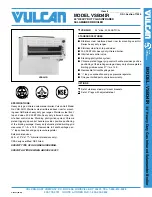
1 Safety
4
Installation manual 0020200969_04
▶
When installing the flue gas installation,
use only flue gas pipes that are made from
the same material.
▶
Do not install any damaged pipes.
▶
File off sharp burrs and chamfer the ends
of the pipes before installing them, and
dispose of the shavings.
▶
Never use mineral-oil-based grease for the
installation.
▶
To facilitate the installation, use only wa-
ter, standard commercial soft soap or, if
required, the supplied lubricant.
Mortar residues, shavings, etc., in the flue
gas route may prevent the flue gas from flow-
ing outdoors as intended, and this flue gas
may escape into the dwelling instead.
▶
After installation, remove all mortar
residues, shavings, etc., from the air/flue
pipe.
1.3.4 Risk of death from leaks in the flue
gas route
Extensions that are not fixed to the wall or
ceiling may become disengaged due to sag-
ging or thermal expansion.
▶
Ensure that every extension is fixed to the
wall or ceiling by means of a pipe clamp.
The distance between two pipe clamps
must not be greater than the length of the
extension, and must not exceed 2 m.
Condensate that collects inside the flue in
certain areas can damage the flue gas pipe
seals.
▶
Install the horizontal flue pipe to the
product with a downward gradient.
–
Downward gradient to the product: 3°
Note
3° corresponds to a downward
gradient of approx. 50 mm per
metre of pipe length.
1.3.5 Risk of fire and damage to
electronics caused by lightning
▶
If the building is equipped with a lightning
protection system, incorporate the air/flue
pipe into the lightning protection.
▶
If the flue gas pipe (parts of the air/flue
pipe situated outside the building) contains
metal materials, incorporate it into the po-
tential equalisation system.
1.3.6 Risk of injury from ice formation
Where air/flue pipes penetrate the roof, the
water vapour contained in flue gas may pre-
cipitate as ice on the roof or the roof struc-
tures.
▶
Ensure that this ice formation does not
slide from the roof.
1.3.7 Risk of damage to the structure of
the building due to moisture
As a result of improper installation, water may
penetrate the building and cause material
damage.
▶
Observe the definitions in the directives for
the planning and implementation of roofs
with seals.
1.3.8 Product damage caused by adjacent
channel vents
1 m
1 m
3 m
H › 0
Extremely damp exhaust air escapes from
the channel vents. This may condense in the
air pipe and cause damage to the product.
▶
Observe the requirements for minimum
clearances in accordance with the illustra-
tion.
1.3.9 Requirements for the air/flue pipe
opening
As a result of improper installation, water may
penetrate the building and cause material
damage.





































